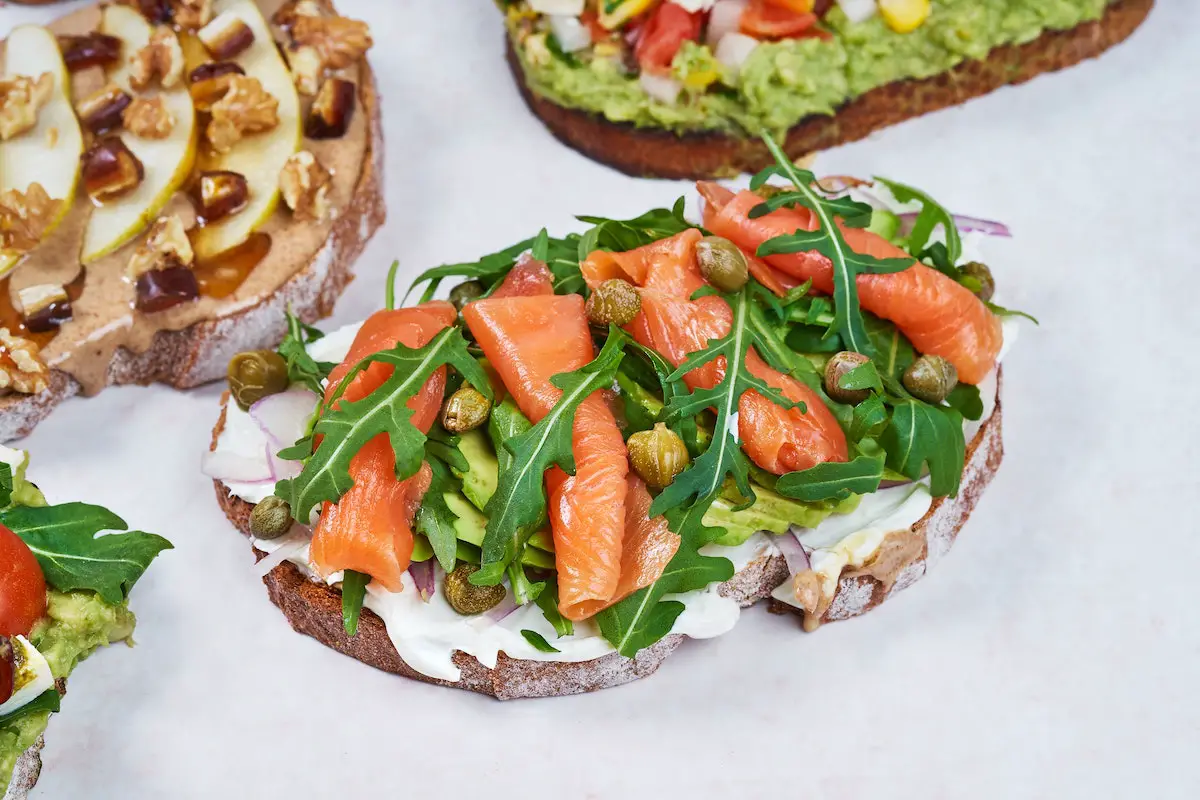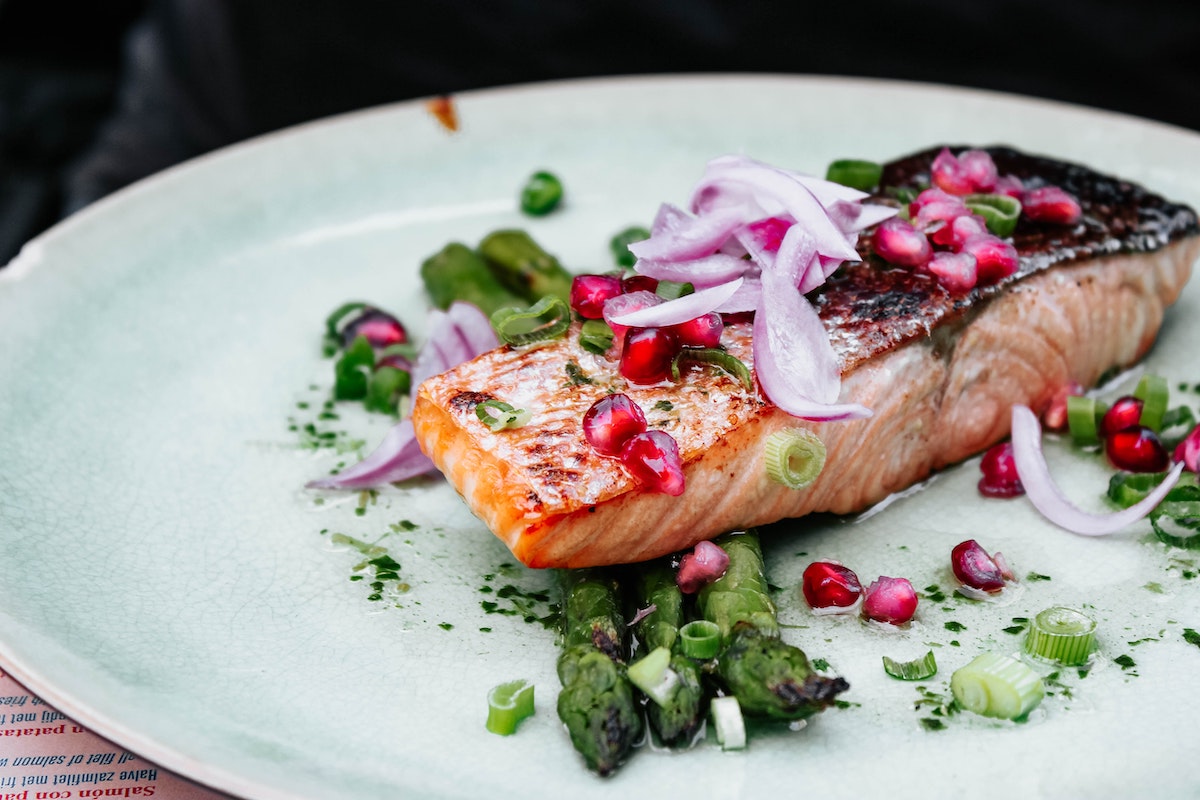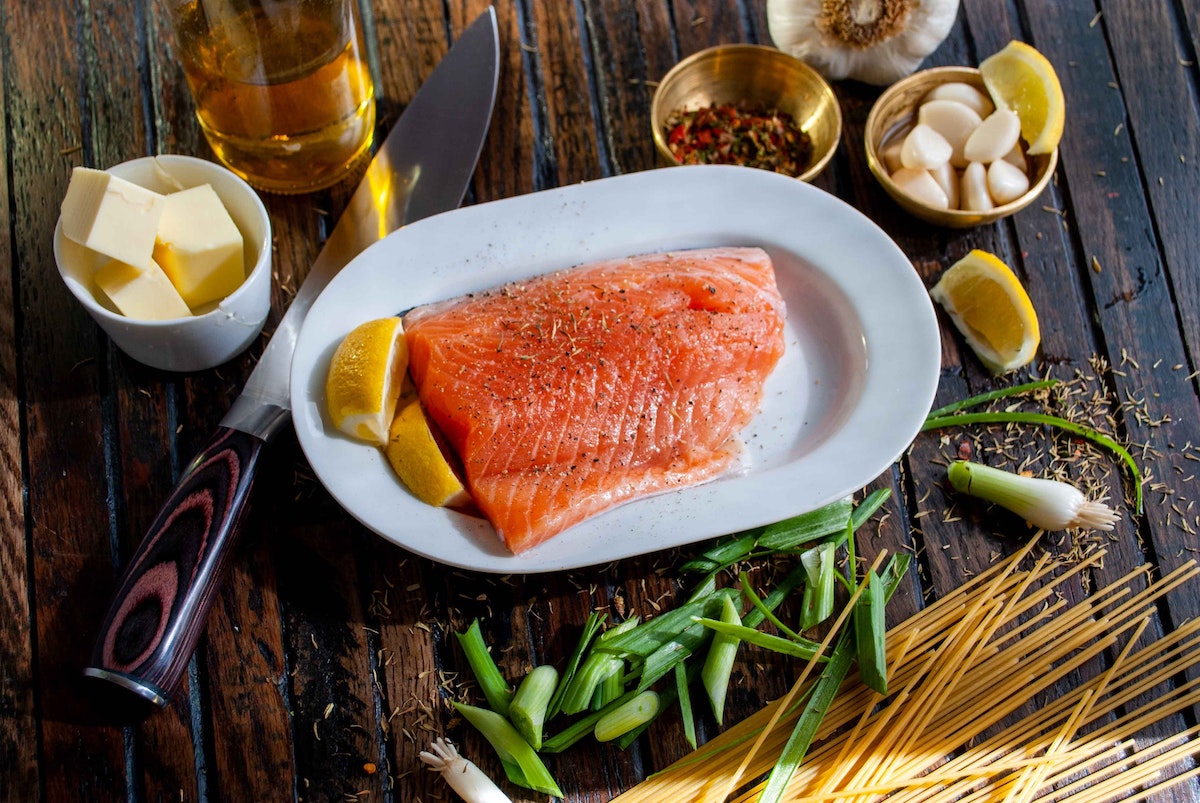Nominated-Day or Next-Day
Nominated-Day or Next-Day

What does salmon taste like? Salmon tastes delicate with a rich flavor, and slightly oily profile. Grilled, baked, or poached salmon often exhibits buttery and citrus notes, complementing the accompanying dish. Smoked salmon has a distinct smoky, mildly fishy taste, while canned salmon may taste bland or oily.
If you’ve never tried salmon, you might be curious about its unique characteristics,, such as its texture, uses, and flavor profile.
Incorporating fish into your diet offers numerous health benefits, and salmon is one of the most delicious and nutritious options.
Salmon is a delicious fish that can be enjoyed across various cuisines due to its adaptability and diverse preparation methods. Its versatility makes it one of the most sought-after fish varieties.
Before we dive into what salmon should look like, smell like, and texture like, let’s delve into the unique flavors of salmon based on different cooking methods.
Remember, the cooking time and temperature are crucial factors in achieving the perfect texture and taste.

Raw salmon has a light, fresh, and slightly citrusy flavor. Its high-fat content imparts a delicious, creamy sensation in your mouth. It pairs well with salty and citrusy sauces like soy sauce or ponzu.
Many people may be hesitant to try raw fish, but salmon is a popular choice in sushi dishes.
Baked salmon’s taste is influenced by the seasonings or marinades used during cooking. Its base flavor is soft, buttery, and smooth.
Salmon can be enhanced by how long it marinades with the flavors.
Complementary flavors for baked salmon include honey mustard, dill, various herbs, dijon, citrus, garlic, and chipotle.
Like baked salmon, poached salmon has a creamy and buttery base flavor that is also influenced by the poaching liquid. To infuse flavor during cooking, use a well-seasoned liquid.
For example, coconut milk with peppers and cilantro can create a delightful Thai taste, while water or broth with herbs like thyme, dill, parsley, or garlic can also yield flavorful results.
Grilled salmon acquires a unique taste when cooked over an open flame or charcoal, resulting in a buttery, spicy, and rich flavor. Using a cedar wood plank when grilling can impart a smoky, woodsy taste to the fish.
Simple ingredients like butter or oil, salt, pepper, garlic, and lemon can effectively flavor grilled salmon.
Though not typically eaten on its own, fried salmon offers a salty and crunchy exterior with a soft, creamy interior. Its flavor is also influenced by the cooking oil.
Fried salmon is often served as fish sticks with cocktail or tartar sauce or as tacos with creamy crema, lime, and cabbage.
The smoking process gives smoked salmon a distinct taste characterized by a smoky, salty, and slightly fishy flavor.
Smoked salmon is often served with bagels for breakfast, pairing well with cream cheese and other bagel toppings like tomatoes, capers, and red onions.
Canned salmon has a light and somewhat bland flavor. If packed in water, it is very mild, while oil-packed salmon has a slightly oily taste.
To enhance its flavor, canned salmon can be used in tuna salad-style dishes or as salmon cakes and burgers.
Salmon, with its striking bright orange-pink hue, is a favorite among seafood lovers across the globe. This anadromous fish species thrive in both saltwater and freshwater environments, primarily inhabiting the Pacific Ocean and various tributaries in the North Atlantic.

The quality of salmon depends on its origin, with wild-caught salmon generally being healthier than farmed varieties. Its meaty texture is less flaky than that of other fish species, like halibut or sea bass, making it a substantial choice for various dishes.
The popularity of salmon in diverse cuisines can be attributed to its adaptability and compatibility with a wide range of flavors. This versatile fish can be found and enjoyed in countless dishes worldwide, making it a staple ingredient for many food enthusiasts.
The aroma of salmon varies depending on its preparation and cooking method. To better understand the scent differences, we’ve categorized the fish by the different ways it can be cooked.
Raw salmon meant for cooking should have a mild, fresh, ocean-like scent. In contrast, hand-rolled/cut roll sushi or sashimi-grade raw salmon should possess a light, salty, and oily aroma without any fishiness.
Selecting the appropriate salmon quality is essential. If either type of raw salmon has an overpowering fishy odor, it may be inedible and should be discarded.
Since baked and poached salmon share similar aromas, they can be grouped together. Both should exude a rich scent that reflects the flavors used in their preparation. For example, honey mustard glazed salmon would smell sweet and tangy.
Salmon should not emit a fishy odor after cooking, as it could indicate spoilage.
Grilled salmon’s aroma resembles that of baked and poached salmon, taking on the scent of spices, herbs, and sauces used in its seasoning. However, grilling over an open flame also imparts a smokey aroma.
When cooked on a cedar plank, the scent may be slightly earthy. A strong fishy odor after grilling could indicate spoilage.
Fried salmon’s scent is heavily influenced by its batter and breading. For example, if coated with panko breadcrumbs, the aroma may have a yeasty undertone.
Fried salmon will always have an oily scent due to its cooking method.
Smoked salmon tends to be the fishiest in aroma compared to other preparations. Its scent is mildly fishy and salty, with a smokey undertone.
As long as the fishiness is not overpowering, it should be safe to consume.
Canned salmon, typically soaked in oil or water, has a mild aroma. It should have a slightly salty and fishy scent.
If it smells rancid or excessively fishy, it’s best to discard it.
The texture of salmon can vary greatly depending on its preparation and cooking techniques. To better understand these differences, we’ve categorized the fish by the various ways it can be cooked.

Raw salmon boasts a smooth, thick, and dense texture with some elasticity. It can be easily sliced, but if it appears sticky or stringy, it may be spoiled and should be discarded.
Baked and grilled salmon share similar textures, characterized by delightful flakiness. When cooked correctly, the salmon meat breaks into large, tender flakes with a silky, buttery quality.
While poached salmon has a similar texture to baked and grilled salmon, it is generally more tender due to being cooked and immersed in liquid.
It doesn’t become as flaky, and the moist cooking method results in a softer, smoother consistency.
Fried salmon stands out with its unique texture. The exterior is crispy, while the interior remains smooth and tender.
The level of crunchiness may vary depending on the cooking method and type of oil used.
Smoked salmon’s texture lies somewhere between raw and cooked salmon. It is slightly firmer than raw salmon due to the smoking process but still maintains a soft and pliable consistency.
Canned salmon has one of the most distinctive textures among all types of salmon. Because it is typically stored in liquids and then canned, it is highly malleable and soft, making it the most adaptable of all the varieties.
Quality salmon should not have a sour or overly fishy taste. In fact, if your salmon tastes excessively fishy, it’s a sign to stop eating it immediately. While salmon might have a slightly fishy aroma before cooking, this smell should dissipate once it’s cooked.
One of the best ways to determine if your salmon is spoiled is by its aroma, color, and texture. Here are some other ways to help you decide if the salmon you’ve bought is safe to consume:
Just as it shouldn’t taste fishy when cooked, the salmon shouldn’t emit a fishy odor after cooking. The cooking process should eliminate any fishy smell, and it should not have an unpleasant or sulfurous odor.
If your salmon has any of these off-putting smells, it’s best to discard it.
Salmon should have a vibrant pinkish-orange hue before and after cooking. If it appears dull, gray, or slightly green before or after cooking, the fish has likely spoiled and should not be consumed.
The texture of your salmon should be appropriate for the preparation and consumption method. For example, smoked salmon and poached salmon will have different textures.
If the salmon feels tough, slimy, sticky, or stringy, it has gone bad and is not suitable for consumption.
Salmon is a versatile fish and can be enjoyed in various ways. If you find high-quality salmon, it can be eaten raw as sushi, sashimi, or poke.
While both salmon and tuna are popular seafood choices, they have distinct flavors. Salmon has a delicate, rich taste with a slightly oily profile, whereas tuna is more robust, meaty, and less oily. Their textures also differ, with salmon being more tender and tuna having a firmer texture.
Salmon does not taste like chicken, as its flavor profile is unique to fish. It has a rich, slightly oily taste with a tender texture. Chicken, on the other hand, has a milder, leaner flavor with a different texture. Comparing the two would not be accurate, as they belong to different food groups and have distinct tastes.
The healthiest fish to eat are those high in omega-3 fatty acids, low in mercury, and sustainably sourced. The healthiest fish you can eat include salmon, sardines, mackerel, herring, and trout. These fish provide essential nutrients, such as omega-3 fatty acids, which support heart and brain health.
Fish with mild, less fishy flavors are popular among those who prefer subtler tastes. Some of the least fishy fish options include cod, tilapia, halibut, haddock, and flounder. These fish have a delicate taste and a more subtle aroma, making them ideal for those who may not enjoy strong fish flavors.
Leave a comment